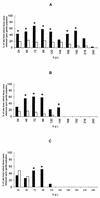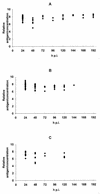Development of a heterologous model in germfree suckling rats for studies of rotavirus diarrhea
- PMID: 9765478
- PMCID: PMC110350
- DOI: 10.1128/JVI.72.11.9298-9302.1998
Development of a heterologous model in germfree suckling rats for studies of rotavirus diarrhea
Abstract
Germfree suckling rats were infected with an SA11 rotavirus strain. Infected pups developed diarrhea associated with histopathological changes. The virus was detected in feces and in the small intestine. Cellular vacuolation was observed in the villi of the jejunum. These results provide a new model for further investigations of group A rotavirus infection.
Figures




Similar articles
-
Neonatal rhesus monkeys as an animal model for rotavirus infection.World J Gastroenterol. 2018 Dec 7;24(45):5109-5119. doi: 10.3748/wjg.v24.i45.5109. World J Gastroenterol. 2018. PMID: 30568388 Free PMC article.
-
Food supplementation with milk fermented by Lactobacillus casei DN-114 001 protects suckling rats from rotavirus-associated diarrhea.J Nutr. 2001 Jan;131(1):111-7. doi: 10.1093/jn/131.1.111. J Nutr. 2001. PMID: 11208946
-
Group A rotavirus infection and age-dependent diarrheal disease in rats: a new animal model to study the pathophysiology of rotavirus infection.J Virol. 2002 Jan;76(1):41-57. doi: 10.1128/jvi.76.1.41-57.2002. J Virol. 2002. PMID: 11739670 Free PMC article.
-
New lessons for rotavirus vaccines.Science. 1996 Apr 5;272(5258):46-8. doi: 10.1126/science.272.5258.46. Science. 1996. PMID: 8600533 Review. No abstract available.
-
Weaning piglets as a model for studying pathophysiology of diarrhea.Vet Q. 1998;20 Suppl 3:S42-5. Vet Q. 1998. PMID: 9689724 Review.
Cited by
-
Neonatal rhesus monkeys as an animal model for rotavirus infection.World J Gastroenterol. 2018 Dec 7;24(45):5109-5119. doi: 10.3748/wjg.v24.i45.5109. World J Gastroenterol. 2018. PMID: 30568388 Free PMC article.
-
Rotavirus-like particles: a novel nanocarrier for the gut.J Biomed Biotechnol. 2010;2010:317545. doi: 10.1155/2010/317545. Epub 2010 Apr 13. J Biomed Biotechnol. 2010. PMID: 20414353 Free PMC article.
-
A combination of scGOS/lcFOS with Bifidobacterium breve M-16V protects suckling rats from rotavirus gastroenteritis.Eur J Nutr. 2017 Jun;56(4):1657-1670. doi: 10.1007/s00394-016-1213-1. Epub 2016 Apr 25. Eur J Nutr. 2017. PMID: 27112962
-
Preventive Effect of a Synbiotic Combination of Galacto- and Fructooligosaccharides Mixture With Bifidobacterium breve M-16V in a Model of Multiple Rotavirus Infections.Front Immunol. 2018 Jun 11;9:1318. doi: 10.3389/fimmu.2018.01318. eCollection 2018. Front Immunol. 2018. PMID: 29942312 Free PMC article.
-
Supplementation With 2'-FL and scGOS/lcFOS Ameliorates Rotavirus-Induced Diarrhea in Suckling Rats.Front Cell Infect Microbiol. 2018 Oct 23;8:372. doi: 10.3389/fcimb.2018.00372. eCollection 2018. Front Cell Infect Microbiol. 2018. PMID: 30406046 Free PMC article.
References
-
- Ball J M, Tian P, Zeng C Q, Morris A P, Estes M K. Age-dependent diarrhea induced by a rotaviral nonstructural glycoprotein. Science. 1996;272:101–104. - PubMed
-
- Bass D M, Mackow E R, Greenberg H B. Identification and partial characterization of a rhesus rotavirus binding glycoprotein on murine enterocytes. Virology. 1991;183:602–610. - PubMed
-
- Bell L M, Clark H F, O’Brien E A, Kornstein M J, Plotkin S A, Offit P A. Gastroenteritis caused by human rotaviruses (serotype three) in a suckling mouse model. Proc Soc Exp Biol Med. 1987;184:127–132. - PubMed
-
- Burns J W, Krishnaney A A, Vo P T, Rouse R V, Anderson L J, Greenberg H B. Analyses of homologous rotavirus infection in the mouse model. Virology. 1995;207:143–153. - PubMed
-
- Burns J W, Greenberg H B. Viral gastroenteritis. Infect Dis Clin Pract. 1994;3:411–417.
Publication types
MeSH terms
Substances
LinkOut - more resources
Full Text Sources
Medical

